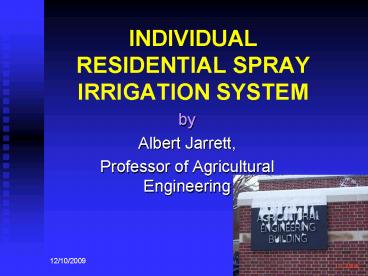INDIVIDUAL RESIDENTIAL SPRAY IRRIGATION SYSTEM - PowerPoint PPT Presentation
1 / 29
Title:
INDIVIDUAL RESIDENTIAL SPRAY IRRIGATION SYSTEM
Description:
Elevated Sand Mounds (Limiting Zone 20 in). Individual Residential ... Scum floats to surface. Two Chamber Septic Tanks required. Treatment Tank. Septic Tank ... – PowerPoint PPT presentation
Number of Views:95
Avg rating:3.0/5.0
Title: INDIVIDUAL RESIDENTIAL SPRAY IRRIGATION SYSTEM
1
INDIVIDUAL RESIDENTIAL SPRAY IRRIGATION SYSTEM
- by
- Albert Jarrett,
- Professor of Agricultural Engineering
2
The Pennsylvania Protocol
- In Chapter 73 (Conventional).
- In-Ground Systems (Limiting Zone gt60 in).
- Beds.
- Trenches.
- Subsurface Sand Filters.
- Elevated Sand Mounds (Limiting Zone gt20 in).
- Individual Residential Spray Irrigation System
- Bedrock Limiting Zone gt 16 in.
- Water Table Limiting Zone gt10 in.
3
Soil Conditions
- Bedrock Limiting Zone gt 16 inches.
- Water Table Limiting Zone gt 10 inches.
gt 16 inches
gt 10 inches
4
IRSIS Overall System(top view)
5
IRSIS Overall System(side view)
- Four Major Components
Treatment Tank
Chlorine Disinfection
Spray Area
Filtration
6
Treatment Processes
- From Home to Treatment Tank.
- Septic Tank
- Solids settle
- Scum floats to surface
- Two Chamber Septic Tanks required.
7
Treatment Tank
- Septic Tank
- Aerobic Tank
8
Treatment Processes
- From the Treatment Tank to the Filtration Unit.
- Three types of Filtration Units (or
Pre-Treatment) have been approved. - Free Access Sand Filter
- Subsurface Sand Filter
- Peat Bio-Filter
9
Free Access Sand Filter (side view)
10
Free Access Sand Filter (top view)
11
Subsurface Sand Filter (partial side view)
12
Subsurface Sand Filter(top view)
13
Peat Bio-Filter
14
Peat Bio-Filter
15
Treatment Processes
- From the Filtration Unit to the Chlorine
Disinfection. - Two types of Chlorine Injection Units have been
approved - Erosion Tablet Units
- Hypochlorite Units.
- These units inject chlorine into the wastewater.
16
Erosion Chlorine Tablet Units
- Advantages
- No Moving Parts
- Low Maintenance
- Less Expensive
- Disadvantages
- Difficult to Calibrate.
- Bridging of Tablets.
17
Hypochlorite Unit
- Advantages
- Does not Bridge.
- Easy to Calibrate.
- Disadvantages
- Moving parts.
- More Expensive.
- Tubing can clog.
- High Maintenance.
18
Treatment Processes
- Following the injection of Chlorine into the
wastewater, the wastewater flows into a large
storage tank. - The storage tank serves two purposes.
- Opportunity for Chlorine contact.
- Storage during inclement weather.
19
Storage Tank and Chlorinator(side view)
20
Storage Tank and Chlorinator(top view)
21
Treatment Processes
- After the chlorine has been injected into the
wastewater, the wastewater must set in a
container for a period of time. - The goal is to provide adequate time for the
chlorine to kill any bacteria remaining in the
wastewater. - Following this contact time, a residual of 0.2 to
2.0 ppm of Cl must remain in the water.
22
Storage Tank
- A portion, usually at least 6 inches depth, of
the storage tank is permanent - This depth is never pumped to
- Ensure Chlorine contact.
- Protect the pump.
23
Storage Tank
- The depth of water above the permanent depth is
to store the daily wastewater flow from the home. - This volume is also available for Chlorine
contact.
24
Storage Tank
- The depth above the daily flow volume is required
to provide several days of storage incase weather
conditions are not suitable for irrigating the
wastewater on any given day.
25
Spray Irrigation
- After midnight, each day, the pump should
activate and the daily wastewater volume should
be pumped to the spray area. - If the weather is inclement, this can be delayed
for a day or so.
26
Spray Irrigation Area
27
Each Sprinkler
28
IRSIS For You??
- This overview of the IRSIS On-Lot Sewage System
may have raised some questions. - If you would like more information about IRSIS,
get ABE Fact Sheet F-16? Or - Contact your Sewage Enforcement Officer (SEO), or
- Contact your County Agent.
29
Thank You

